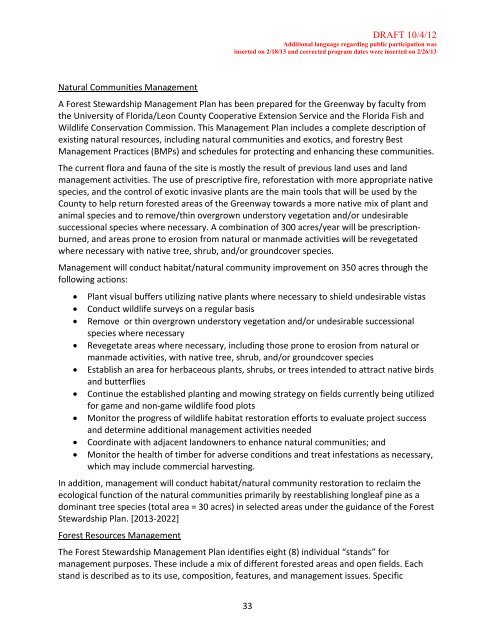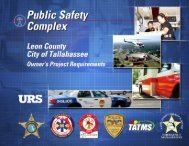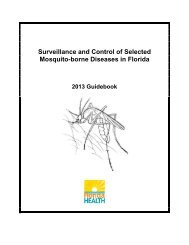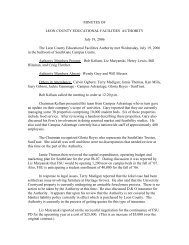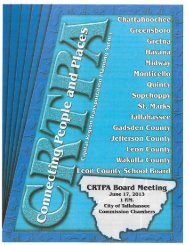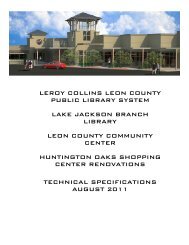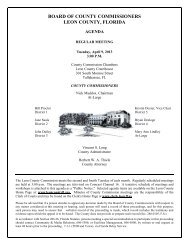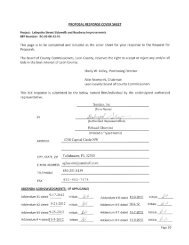J.R. Alford Greenway - Leon County
J.R. Alford Greenway - Leon County
J.R. Alford Greenway - Leon County
Create successful ePaper yourself
Turn your PDF publications into a flip-book with our unique Google optimized e-Paper software.
DRAFT 10/4/12<br />
Additional language regarding public participation was<br />
inserted on 2/18/13 and corrected program dates were inserted on 2/26/13<br />
Natural Communities Management<br />
A Forest Stewardship Management Plan has been prepared for the <strong>Greenway</strong> by faculty from<br />
the University of Florida/<strong>Leon</strong> <strong>County</strong> Cooperative Extension Service and the Florida Fish and<br />
Wildlife Conservation Commission. This Management Plan includes a complete description of<br />
existing natural resources, including natural communities and exotics, and forestry Best<br />
Management Practices (BMPs) and schedules for protecting and enhancing these communities.<br />
The current flora and fauna of the site is mostly the result of previous land uses and land<br />
management activities. The use of prescriptive fire, reforestation with more appropriate native<br />
species, and the control of exotic invasive plants are the main tools that will be used by the<br />
<strong>County</strong> to help return forested areas of the <strong>Greenway</strong> towards a more native mix of plant and<br />
animal species and to remove/thin overgrown understory vegetation and/or undesirable<br />
successional species where necessary. A combination of 300 acres/year will be prescription‐<br />
burned, and areas prone to erosion from natural or manmade activities will be revegetated<br />
where necessary with native tree, shrub, and/or groundcover species.<br />
Management will conduct habitat/natural community improvement on 350 acres through the<br />
following actions:<br />
Plant visual buffers utilizing native plants where necessary to shield undesirable vistas<br />
Conduct wildlife surveys on a regular basis<br />
Remove or thin overgrown understory vegetation and/or undesirable successional<br />
species where necessary<br />
Revegetate areas where necessary, including those prone to erosion from natural or<br />
manmade activities, with native tree, shrub, and/or groundcover species<br />
Establish an area for herbaceous plants, shrubs, or trees intended to attract native birds<br />
and butterflies<br />
Continue the established planting and mowing strategy on fields currently being utilized<br />
for game and non‐game wildlife food plots<br />
Monitor the progress of wildlife habitat restoration efforts to evaluate project success<br />
and determine additional management activities needed<br />
Coordinate with adjacent landowners to enhance natural communities; and<br />
Monitor the health of timber for adverse conditions and treat infestations as necessary,<br />
which may include commercial harvesting.<br />
In addition, management will conduct habitat/natural community restoration to reclaim the<br />
ecological function of the natural communities primarily by reestablishing longleaf pine as a<br />
dominant tree species (total area = 30 acres) in selected areas under the guidance of the Forest<br />
Stewardship Plan. [2013‐2022]<br />
Forest Resources Management<br />
The Forest Stewardship Management Plan identifies eight (8) individual “stands” for<br />
management purposes. These include a mix of different forested areas and open fields. Each<br />
stand is described as to its use, composition, features, and management issues. Specific<br />
33


